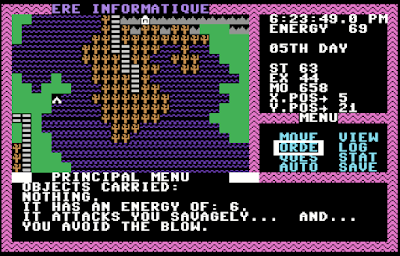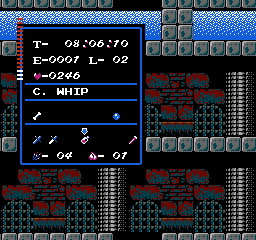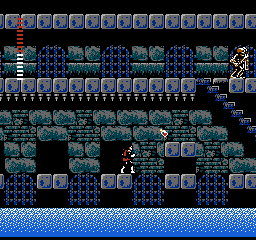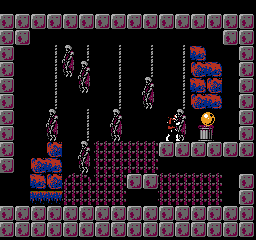Bob's Dragon Hunt
Neurosport (developer and publisher)
AntKill
Crystal Deception
United StatesNeurosport (developer and publisher)
Released in 1992 for DOS as shareware
The "Bob" in Bob's Dragon Hunt is Robert Kemp, co-owner of Neurosport, which he founded with Faron Wickey in 1990. The developers produced several games:
- Majik (1991)
- Antkill (1992)
- Bob's Dragon Hunt (1992)
- Crystal Deception (1992)
- Spacekill I: Defender (1992)
- Spacekill II (1992 or 1993)
There are several problems playing the company's games today. First, they used a shareware model for dissemination, and all but demo copies of the titles seem to have been lost. The second is that even some of the full games, while completely playable, are meant as "teasers" for longer cousins. Bob's Dragon Hunt and AntKill are meant more to showcase the technology used for Crystal Deception than to constitute full RPG experiences themselves; the same is true of Spacekill I and Spacekill II (neither of which are RPGs). Third, the technology doesn't hold up well 30 years later via an emulator. Kemp mentioned in correspondence to me that they implemented timers using CPU cycles, so calibrating the games in DOSBox is something of an effort.
To illustrate these issues, we turn to Bob's Dragon Hunt, the first of three "games" to feature Neurosport's "VirtualDungeon" technology. Their game manuals suggest that they intended "VirtualDungeon" to be the master title for the series (e.g., VirtualDungeon I: Bob's Dragon Hunt; VirtualDungeon II: Antkill), but none of the title screens reflect that.
I have no idea what's happening when you first launch the game. It mimics the sound of a telephone ringing, and then a digitized voice says: "Hello? Wow! You got it! Goodbye!" just before a bloopish version of John Philip Sousa's The Liberty Bell March plays on a loop. (In an e-mail, Kemp says they threw in the sound "on a lark" because they liked the freeware program that generated it.)
The pre-title screens cover the backstory: You are Bob, a young lad in the town of Wontbe in the kingdom of Neverwas. Every year, dragons fly down from the mountains in the spring and slaughter the town's livestock, an event the simple townsfolk are helpless to prevent. But one day, Bob discovers a magic ring that turns him into a different sort of hero every time he slips it on. He formulates a plan to invade the dragons' caves and kill them so that his town will grow prosperous.
There is no character creation. The game jokingly offers you the ability to specify a name, but then insists that you are "Bob" no matter what name you choose. ("After all, it's Bob's Dragon Hunt, not Leroy's," Kemp joked in an e-mail exchange.) You are then thrust into the dungeon "in the body" of a character whose class and level are chosen at random from roughly Levels 18-24 and classes of knight, ranger, fighter, druid, assassin, monk, and thief. Your pack is stuffed full of items, and in fact the game has no problem starting you so overloaded that you can't move and trying to execute any command simply informs you that you have "collapsed under the load." You have to waste time, while getting attacked by dragons, equipping and dropping items.
The commands and inventory items show, as with the previous Majik, a heavy roguelike influence. The long list of key commands uses both upper- and lower-case variants of the same letter (e.g., d)rop and D)isarm trap) and includes such roguelike derivatives as q)uaff and z)ap a wand. Any item can have seemingly any condition attached, so you might start the game with a Potion of Cure Blindness, a Mushroom of Invisibility, a Earring of Resist Lightning, a Silver Executioner's Sword of Tunnelling, and a Shield of Bashing. Items can be blessed or cursed.
The interface showcases the company's unique graphical approach in which walls, floors, and monsters' body parts are depicted using filled polygons. While I grant that it's an original approach, I'm not sure that in practice the graphics are notably better than the wireframes we already had in games like Wizardry and Might and Magic. There are some odd consequences to the effect, such as all the walls appearing to be octagonal pillars. It works well for the dragons' wings.
 |
| Multicolored polygons create decent wings but weird walls. |
The rest of the interface, including movement, is occasionally incomprehensible. You get a hit point and mana meter, which I guess are easy enough, but I have no idea what the two radars beneath the bars are attempting to show. The left one just rattles around constantly. The right one almost seems to be telling you what direction you're facing, but it moves unpredictably. For instance, it's pointing north as I face a particular wall. I turn right and it points east. So far so good. Then I turn left, facing the original wall, and the pointer turns to point south. The automap at the bottom of the panel is a tiny mess.
 |
| "Cold breath" depicted with a variety of polygons. |
The arrow keys and numberpad take a long time to get used to, partly because there are eight facing directions (that is, each "turn" turns you only 45 degrees). The numberpad keys move you without changing the direction you're facing. Only the + and - keys actually turn you right and left. It's an absurd system for a first-person game. I think I speak for 99% of players when I say that in a first-person view, I want the right arrow to turn me right, not move me east.
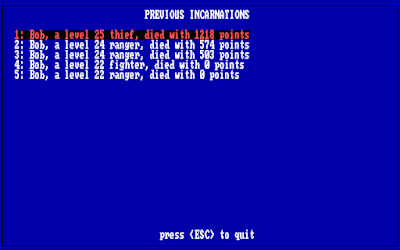 |
| A high position on the leaderboard seems to be the only point of the game. |
Combat comes along in a cacophony of screeches, static, and flashing colors. A jagged line of polygons meant to represent a dragon's breath hits you--green for poison, white for ice, and so on. You get points for every enemy you kill. When death comes, and it will come swiftly, your final score is tallied on a leaderboard, which is a little pointless since all the characters are "Bob."
Although the enemies' attacks are animated, the game still maintains the turn-based nature of its roguelike sources. You have time to plan and think. The respawn rate is a bit high though.
Enemies are mostly draconic: dragons, dragon lizards, dragon bats (plus separate dracobats), dragon snakes. There are more pedestrian foes, too, like druids, townsmen, and anacondas. These enemies have a wide variety of special attacks and defenses, some at least partly randomized. The thought and programming that went into these special attacks and defenses is admirable, but Hunt doesn't showcase it very well by dumping you into a single level in which any enemy can appear right away, rather than letting you build your knowledge base slowly from level one (which, admittedly, is what Crystal Deception is for). Some players might compliment the freshness of this approach, but I found it too much at once.
I did my best to last as long as I could on each randomly-generated level. The best I got in a few hours of playing was 1,218 points (which included leveling up a few times). I found trees, bushes, and water squares in some of the levels but never any stairs up or down. I'm not sure if they exist.
AntKill reskins Bob's Dragon Hunt with colors that suggest a desert setting. Most of the monsters become varieties of ants. The player has no defined class, starting level is around 10, and starting equipment is both reduced and nonmagical.
AntKill begins on an outdoor map swarming with so many ants that, just to move, you have to jack the emulator to speeds that era players could only dream of. You can descend into the ant hill via a network of tunnels, with enemies getting harder as you go down. I didn't find any equipment in my travels except for food. As with Hunt, death puts you on a leaderboard with your score. In this game, however, you can specify a unique name for each character. AntKill also allows saving and reloading, which Hunt does not.
 |
| Fighting a swarm of ants in the outdoor area. |
I can't claim that either game isn't an RPG. They both feature experience and leveling (which grants more maximum hit points and mana) and both have RPG-style combat and inventories. Hunt's is particularly extensive. I don't know for sure if either game has a winning condition. Online, there's some talk about a three-headed hydra in Hunt and an ant queen in AntKill, but I don't know if killing either ends the game. Overall, though, comments from Bob Kemp have made it clear that both titles (plus an unreleased VirtualDungeon III: Night on Bald Mountain) were intended as teasers for the real game, which no longer seems to exist: Crystal Deception. It was sold only by mail-order, and it was reportedly a full game, starting at Level 1.
The idea of fusing roguelike mechanics with a first-person interface is good on its surface, but this specific interface either hasn't aged well or was always chaotic and confusing. In some ways it's too bad that Hunt and AntKill aren't more playable, as the developers clearly spent a lot of time on the combat, spells, and inventory mechanics. Hunt has a whole mechanic for taming monsters that I was unable to figure out. What you really need is the opportunity to learn this engine slowly, from Level 1, acquiring each item one at a time--not suddenly thrown into a packed dungeon at Level 20 with two dozen items. If Deception ever turns up, I gather that's what it will offer.
Frequent CRPG Addict commenter Rowan Lipkovits forwarded me some correspondence that he had with Kemp in 2019, which led to some further correspondence between me and Kemp this week. I shared with him a draft of this entry, and he clarified some points but couldn't remember others. He bore my criticisms well, though reminded me several times that the company consisted of two guys feeling things out for the first time in an era in which there was limited technology and few established standards. Kemp remains proud of his innovations, some of which (as a non-programmer), I didn't fully understand. I'll offer this paragraph for the more tech-oriented among my readers:
The VirtualDungeon was a mini operating system that managed all the objects in the game. We were doing object oriented programming before it was invented. The monster/item behaviors were lists of functions in the data structure. The VirtDun code cycles through them all choosing behaviors/actions randomly (or by % in the structure) and calling those functions along with any data they need as specified in the data description. It also handled timer calls and dispatches. This allowed the spawner to create random monsters/items from data structures which also had included "must have" and "may have" flags. All the functions followed a required template which allowed all the "spells" to be portable and used by any method (zapping, invoking, on impact, etc.) on any item and mostly by any monster (e.g., the fireball spell was used by the red dragon as a breath attack). As a core, the Virtual Dungeon would be usable today as-is and I'm seriously hoping to find a copy and not having to rewrite it.
Both Kemp and Wickey had left more lucrative technology jobs to make an effort at running a game company, and they had the misfortune of trying to market a 3D engine in the same year that DOOM was released (Kemp notes ironically that id Software's headquarters was just a few miles away from Neurosport's). While Neurosport made money, it wasn't enough to compete with the offers the pair were getting in other industries. Both partners took other jobs, and Neurosport quietly dissolved. Wickey, a quadriplegic since a sledding accident at age 21, died in 2019 at age 63, a year after suffering a horrific assault from his mentally-ill roommate.
Kemp has plans to get back into game programming. He's currently exploring options using the Unity 3D system. If it results in a full game, perhaps I'll get to it in a few years. In the meantime, Kemp still hopes a CD with Crystal Deception will turn up. If anyone reading this has one, I'll be glad to pass along your contact info.




























